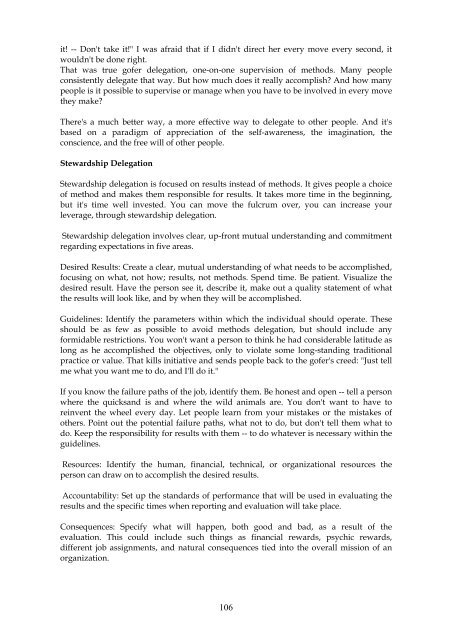Covey - The 7 habits of highly effective people
Create successful ePaper yourself
Turn your PDF publications into a flip-book with our unique Google optimized e-Paper software.
it! -- Don't take it!" I was afraid that if I didn't direct her every move every second, it<br />
wouldn't be done right.<br />
That was true g<strong>of</strong>er delegation, one-on-one supervision <strong>of</strong> methods. Many <strong>people</strong><br />
consistently delegate that way. But how much does it really accomplish? And how many<br />
<strong>people</strong> is it possible to supervise or manage when you have to be involved in every move<br />
they make?<br />
<strong>The</strong>re's a much better way, a more <strong>effective</strong> way to delegate to other <strong>people</strong>. And it's<br />
based on a paradigm <strong>of</strong> appreciation <strong>of</strong> the self-awareness, the imagination, the<br />
conscience, and the free will <strong>of</strong> other <strong>people</strong>.<br />
Stewardship Delegation<br />
Stewardship delegation is focused on results instead <strong>of</strong> methods. It gives <strong>people</strong> a choice<br />
<strong>of</strong> method and makes them responsible for results. It takes more time in the beginning,<br />
but it's time well invested. You can move the fulcrum over, you can increase your<br />
leverage, through stewardship delegation.<br />
Stewardship delegation involves clear, up-front mutual understanding and commitment<br />
regarding expectations in five areas.<br />
Desired Results: Create a clear, mutual understanding <strong>of</strong> what needs to be accomplished,<br />
focusing on what, not how; results, not methods. Spend time. Be patient. Visualize the<br />
desired result. Have the person see it, describe it, make out a quality statement <strong>of</strong> what<br />
the results will look like, and by when they will be accomplished.<br />
Guidelines: Identify the parameters within which the individual should operate. <strong>The</strong>se<br />
should be as few as possible to avoid methods delegation, but should include any<br />
formidable restrictions. You won't want a person to think he had considerable latitude as<br />
long as he accomplished the objectives, only to violate some long-standing traditional<br />
practice or value. That kills initiative and sends <strong>people</strong> back to the g<strong>of</strong>er's creed: "Just tell<br />
me what you want me to do, and I'll do it."<br />
If you know the failure paths <strong>of</strong> the job, identify them. Be honest and open -- tell a person<br />
where the quicksand is and where the wild animals are. You don't want to have to<br />
reinvent the wheel every day. Let <strong>people</strong> learn from your mistakes or the mistakes <strong>of</strong><br />
others. Point out the potential failure paths, what not to do, but don't tell them what to<br />
do. Keep the responsibility for results with them -- to do whatever is necessary within the<br />
guidelines.<br />
Resources: Identify the human, financial, technical, or organizational resources the<br />
person can draw on to accomplish the desired results.<br />
Accountability: Set up the standards <strong>of</strong> performance that will be used in evaluating the<br />
results and the specific times when reporting and evaluation will take place.<br />
Consequences: Specify what will happen, both good and bad, as a result <strong>of</strong> the<br />
evaluation. This could include such things as financial rewards, psychic rewards,<br />
different job assignments, and natural consequences tied into the overall mission <strong>of</strong> an<br />
organization.<br />
106


